by Baxter
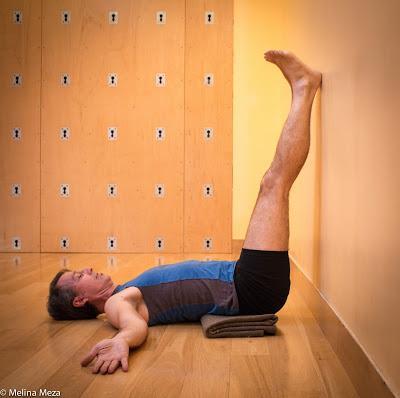 This is one of our students’ very favorite poses (and ours, too!). Because this pose is a supported inversion, it triggers the relaxation response, so it’s an excellent remedy for stress and anxiety. And because is very comfortable for most people and the support of the wall or chair allows you to stay in the pose for 10 to 20 minutes, it allows you to spend an extended period in the Rest and Digest state, which will benefit your digestion and immune system.
This is one of our students’ very favorite poses (and ours, too!). Because this pose is a supported inversion, it triggers the relaxation response, so it’s an excellent remedy for stress and anxiety. And because is very comfortable for most people and the support of the wall or chair allows you to stay in the pose for 10 to 20 minutes, it allows you to spend an extended period in the Rest and Digest state, which will benefit your digestion and immune system.The pose also provides physical benefits. It stretches the backs of your legs and the versions with a lifted pelvis open your chest and help restore the natural curve of your spine. Because the pose reverses the effects of gravity on your legs, it can help with swelling of the feet and ankles.
Baxter prescribes this for:
- leg fatigue
- peripheral edema (swelling of feet and legs)
- low back pain
- foot pain
- recovery from ankle sprains or plantar fasciitis
- stress management
- anxiety or agitation
Timing: As long as you are comfortable, hold the pose for 10 or more minutes. If your feet or legs begin to tingle or fall asleep, try bending your knees slightly to see if that helps, or come out of the pose. Using a timer may help you relax more completely. When you come out of the pose, sit for a minute or so on your prop (if you are using one) with your back to the wall before moving on.
Cautions: This pose is generally very safe, especially version 4. Just be careful to guide yourself into the pose slowly to avoid dropping your head too quickly to the floor. Those of you with symptomatic hiatal hernias or acid reflux may not be able to lie flat, so try keeping your hips on the floor but add a prop under your chest (as in Reclining Cobblers with a blanket support for spine and head) or skip the pose entirely.
1. Classic Version
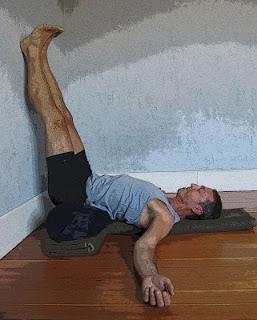
(Sorry, photo doesn't match prop description—need a new one—although this is a good way to practice, too.)
To set up, place your mat with the short end at the wall. Then place a bolster on the mat so it is about six inches away from the wall (depending on your body type, you may need to move it further away) and parallel to it.To come into the pose, sit near the end of the bolster with your side to the wall, knees bent and feet on the floor. Then swivel toward the wall, extending your legs up the wall as you use your hands to slowly lower your chest and head to the mat. Make sure the back of your pelvis is resting evenly on the top center of the bolster, that your legs are straight, and your feet are hips-distance apart, with the heels resting on the wall. (If you can’t straighten your legs in the pose, try moving the bolster further from the wall or practice version 4.) Relax your arms out to your sides in a comfortable position. Once you’re comfortable, close your eyes and practice either simple breath awareness or your meditation technique.
To come out of the pose, slide your feet down the wall and bend your knees towards your chest. Then, gently roll to one side to come off the bolster and use your hands to slowly press yourself up to sitting.
2. Pelvis on a Blanket
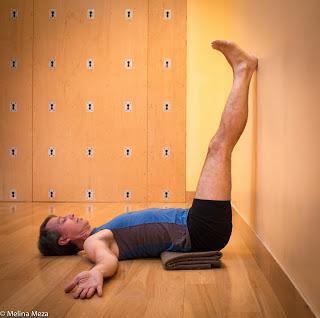
To set up, fold a blanket into a long, narrow rectangle that is about the same length and width as a bolster. Then set up as you would for the classic pose using the blanket in place of the bolster. To come into the pose, sit on the end of the blanket with your side to the wall, your knees bent and soles of the feet on the floor. Then follow the instructions for entering classic pose, adjusting the position of your pelvis and the prop if needed. Once you are comfortable, follow the instructions in the classic version for finding a mental focus.
To come out of the pose, follow the instructions for the classic version.
3. Legs Up the Wall with No Pelvic Support
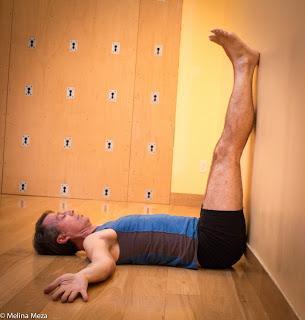
To come into the pose, sit with your side to the wall, about 6 inches from the wall, with your knees bent and soles of the feet on the floor. Then follow the instructions for entering classic pose. After you’re up, you can shift your pelvis closer or further from the wall if necessary.
Once you are comfortable, follow the instructions in the classic version for finding a mental focus. To come out of the pose, follow the instructions for the classic version.
4. Easy Inverted Pose
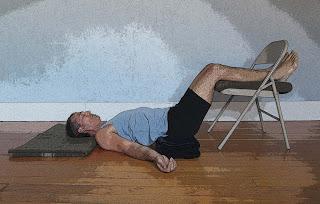
To set up, position your mat away from the wall with a chair at one end of the mat, facing the other end. Place a folded blanket or yoga mat on the chair seat. Fold one or two blankets into long, thin rectangles the size of a bolster, and place it (or them) about a foot away from the chair seat. If desired, you can place another folded blanket on the mat to cushion your head.
To come into the pose, sit near the end of the rectangular blanket, with your side to the chair, knees bent and feet on the floor. Then swing your calves up onto chair seat as you use your hands to guide your torso and head to the floor. If your calves are not resting comfortably on the chair seat, adjust the position of the your hips (and the prop) closer or further to the chair, as needed. Most of you will need to extend your feet through the space between the chair seat and back. Once you are comfortable, follow the instructions in the classic version for finding a mental focus.
To come out of the pose, move your knees towards your chest and place your feet on the front edge of the chair. Then following the instructions for coming out of the classic version.
Subscribe to Yoga for Healthy Aging by Email ° Follow Yoga for Healthy Aging on Facebook ° Join this site with Google Friend Connect

